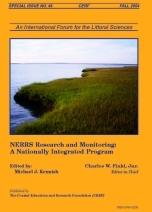Shallow estuarine habitats are normally characterized by wide interannual and intraannual fluctuations in water-quality variables, including dissolved oxygen; however, the short-term variability in water-quality variables is seldom measured and characterized. Water-quality data collected semicontinuously by automated data sondes from 1995 to 2000 at 55 sites among 22 National Estuarine Research Reserves (NERR) were analyzed to characterize temporal variability and compare conditions among estuarine systems and regions. Three-way analysis of variance (ANOVA) models revealed several significant interannual and seasonal differences for water-quality variables for many sites sampled within a reserve; however, interannual trends with respect to reserve or region were not readily apparent. Salinity and hypoxic events (dissolved oxygen [DO] < 28% saturation [sat]) were generally greatest in summer or fall. Evapotranspiration and precipitation appeared to influence seasonal salinity patterns at reserve sites. Abrupt short-term decreases and sustained long-term decreases in salinity associated with precipitation events were documented during the passage of tropical systems. An abrupt decrease in water temperature prior to storm passage was noted, with increasing cooling effects related to increasing storm intensity. Although hypoxia occurred over a broad geographic range, it was primarily experienced at sites with sustained warm water conditions. Hypoxia was strongly influenced by latitude and climate. Duration of hypoxia at most reserves persisted less than 12 hours. Increased deployment duration was shown to increase the percentage of time with hypoxic conditions (DO < 28% sat) and decrease the percentage of time with supersaturation (DO > 120% sat) at many sites. The large fluctuations in dissolved oxygen that occur over short time periods in estuaries demonstrate the need for long-term continuous measurements to estimate the frequency and duration of exposure to low DO. Without continuous monitoring, many low-DO events would have been missed, thus underestimating the potential impacts from this type of water-quality variability. The synthesis of water-quality data from the NERR sites indicates that reserves have not experienced many of the problems found in other more populated locales.
How to translate text using browser tools
1 November 2004
Variability in Dissolved Oxygen and Other Water-Quality Variables Within the National Estuarine Research Reserve System
Elizabeth Wenner,
Denise Sanger,
Michael Arendt,
A. Frederick Holland,
Yian Chen
ACCESS THE FULL ARTICLE

Journal of Coastal Research
Vol. 2009 • No. 10045
Fall 2004
Vol. 2009 • No. 10045
Fall 2004
estuaries
hypoxia
National Estuarine Research Reserve
tropical storms
Water-quality monitoring




